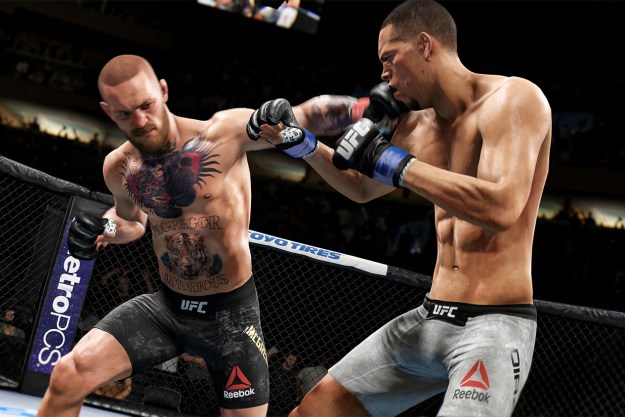
“A satisfying knockout is just one well-placed combination away in ‘UFC 3’”
- Captures the unpredictably of MMA
- Great offensive and defensive balance
- Fluid animations
- Escaping from grapples is cumbersome
- Ultimate Team collectibles feel out of place
Since taking over the license in 2012, EA Sports’ UFC series has become predictable. Both 2014’s EA Sports UFC and 2016’s UFC 2 replicated the look and mechanics of mixed martial arts well, but failed to create gameplay that simulated the rapid shifts in momentum that make MMA so enthralling. Fights tended to drag out long after it seemed a knockout had been earned, and there was little threat of a match turning sideways for playing recklessly. It was a balanced game, but an essential element of the MMA experience was lost.
After spending a few days with the closed beta for UFC 3, it seems that the third time’s the charm. Developer EA Vancouver has made crucial changes to create a more authentic MMA sim, which better represents your skills in the octagon in ways that will make sense to MMA fans.
“Let the bodies hit the floor”
Less than 20 seconds into our first fight we saw the new, more pronounced strike system at work, while playing as Conor McGregor. We delivered a vicious uppercut to an AI-controlled Nate Diaz that sent him straight to the floor. Diaz promptly got back to his feet, but the damage was already done. After a few well-placed jabs, a crossover, and a grisly left hook, Diaz was down for the count.
Through a couple of big tweaks and some new systems, UFC 3 changes the fundamentals of how fighters deal and take damage. Every strike is more meaningful. Fighters take much more damage per blow, and you can be knocked out in less than minute if you aren’t careful. (Luckily, the same goes for knocking your foe out).
The game takes further steps to emphasize momentum, thanks to a pair of new meters that scale the impact of repeated attacks and rapid dominance. The stun meter, which charts how long it takes for a fighter to recover from getting hit (and is hidden, despite the name), varies depending on how much damage you’ve taken recently, as well as how much you’ve taken throughout the fight. The more a fighter is hit in quick succession, the more staggered they become. And If you take too much damage throughout a fight, the meter completely stops replenishing, leaving you open for devastating blows, and reduced movement efficiency.
The chin meter, which specifically charts how much you’ve been hit in the head, lowers as a fighter is knocked down or stunned. As the severity of the damage to a fighter’s noggin increases — the announcers comment on it — the chance of being knocked down, or out, increases.
Positioning is more important than ever, especially when it comes to movement. We found that out the hard way when, in one bout, we moved towards our opponent, only to receive a kick to the head that knocked us off our feet. In past games, taking a shot while moving inflicted more damage. Now, leaving yourself exposed in your opponent’s range can quickly lead to a loss.
These changes, when coupled with the way health recovers — the higher your health is, the slower it regenerates — encourages precision, and allows for skilled players to make quick work of unskilled opponents.
UFC 3, like its predecessors, features quality animations.
You might imagine that this pushes players to simply fight as aggressively as possible, but there are checks in place to keep fighters honest. The stamina system has been reworked to affect the impact of your strikes, which keeps the increased damage from becoming abused.
Throwing a series of missed punches and then landing one solid haymaker doesn’t help you much, since your stamina will be shot. The lower your stamina, the less damage you inflict, further emphasizing that the best course of action is a combination leading into a blocking stance while the meter refills.
Not only are these differences engaging, but they are stunning to watch. UFC 3, like its predecessors, features quality animations, and these are the best yet.
Gloves up
With the change to how you gain stamina, UFC 3 now has a strong emphasis on active defense — more blocking, fewer counterattacks. You can no longer use parries to make a rapid counterattack from a defensive stance. That’s sure to disappoint defensive minded fighters, but with the changes to offense, it makes sense that the game emphasizes blocking punches to avoid damage, rather than to inflict sizable damage of your own.
Defensive fighters will appreciate the changes to slipping – the game’s term for dodging — and lunges. You can now dodge while moving, which helps avoid damage while getting back into or escaping range. Advanced and signature lunges have joined the default ones, giving you more ways to elude hairy situations.
The one aspect of gameplay that hasn’t seen radical changes is the ground game. The analog stick guessing game used to escape a hold remains, as do other ground game maneuvers. The trickiness of on the floor maneuvers is understandable — it should be hard to escape holds. But the cumbersome nature of executing these moves feels out of place amongst the otherwise greatly enhanced fight mechanics.
Do we really need “UFC Ultimate Team?”
Ultimate Team, EA Sports’ card collecting challenge mode, works great in FIFA and Madden. Acquiring cards has a way of making you feel like a kid again, and makes some thematic sense in those franchises, but it feels forced in UFC.
Ultimate Team feels forced and runs counterintuitive to the meaningful gameplay changes
Bringing UFC 3 closer to its EA Sports counterparts, fighters can be acquired via card packs, along with the standard perks, boosts, and moves present in UFC 2. Given the comparatively small pool of “players” to collect, though, it doesn’t have the same luster here.
As in Madden 18 and FIFA 18, strike cards now have chemistry ratings, which can impact your fighter’s overall skill set when compatible moves are equipped to a fighter. Punches, kicks, and grapples can all increase your fighter’s chemistry, and provide a tactical advantage when used. While the chemistry ratings make sense in team-based games like Madden and FIFA, that system doesn’t seem logical here.
The system also doesn’t gel well with UFC’s gameplay. Applying stamina and damage boost cards — which alter the new, balanced system — runs counter to an experience that hinges on swift reversals of fortune. It’s easy to see how Ultimate Team could lead to an exploitative, pay-to-win pursuit of easy knockouts, instead of the deep collectable mode found in EA Sports’ other franchises.
While Ultimate Team feels out of place, the core of UFC 3 may create a more realistic sim than its predecessors. Its emphasis on knowing when to take calculated risks leads to visceral fights that can change trajectory with one big strike.
Look for our full thoughts when UFC 3 launches for PlayStation 4 and Xbox One on February 2, 2018.
Editors' Recommendations
- Best PlayStation Plus Deals: Save on Essential, Plus and Premium
- The best cozy games
- Best gaming console deals: cheapest prices on PS5, Xbox S and X and Switch
- Xbox Game Pass loses some horror greats, but gains a kid-friendly racing game
- Best PlayStation deals: PS5, controllers, headsets on sale










